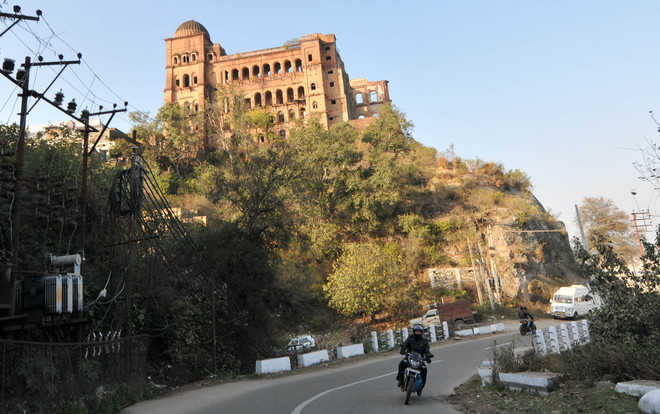
The Mubarak Mandi heritage complex in Jammu. Tribune photo: Inderjeet Singh
Sumit Hakhoo
Tribune News Service
Jammu, February 8
Once considered as most oriental and picturesque towns in the Indian subcontinent, Jammu has been reduced to a mere transit city for tourists and pilgrims. All this is due to non-assertive local populace which has failed to safeguard their heritage and six decades of political discrimination, which the city faced after the fall of the Dogra dynasty in 1947.
The royal cultural imprints are still clearly evident from the names of the places located well in the heart of the city, but importance given to the protection and conservation of monuments, buildings and sites is very less as compared to other cities in India.
Ancient references regarding the town of Jammu are found in the Malfuzat-i-Taimuri, which describes the invasion of Timur of the Sivalik in 1399 AD, but today the city has almost “vanished” from the tourist map.
Majority of the projects to renovate historical sites are running behind schedule or have been scrapped, while its markets, once hosting traders from Afghanistan, Peshawar, Tibet and Central Asia, are a shambles.
Several initiatives taken about a decade ago, including beautification of Mubarak Mandi palace, Buddhist heritage site at Ambran, Akhnoor, temple complex at Purmandal and Mubarak Mandi-Bahu Fort ropeway, are yet to be completed.
A special task force for Jammu, constituted in 2010, had recommended that tourism promotion schemes should be completed on the fast track, but it has been neglected. Most of the works are pending due to fund shortage, while successive governments have not shown keenness in promoting tourism in Jammu.
Neglected markets
For more than a century the Kanak Mandi, Rajinder market and Raghunath Bazaar remained a major commercial transit for traders across Jammu and Kashmir, but due to indifference of successive governments they have lost their grandeur.
Adjoining to each other these markets flourished during the reign of erstwhile Dogra rulers from 1850s, but today they are identified with long queues of vehicles and crumbling old structures with dilapidated civic infrastructure. A project to develop Raghunath Bazaar as historical souvenir in 2008 is yet to be completed, while other projects are running behind schedule.
The place where the Rajas of Jammu received the “rajtilak” or mark of investiture was popularly known as the Rajtilak road, now Purani Mandi, but no effort has been made to save it as heritage spot. Historical records say that Purani Mandi is the spot where the palace of Jambulochan existed, but today it is just a concrete jungle.
Bahu Fort ropeway project
The state Cabinet had given go ahead to the project in 1996 when Farooq Abdullah was the Chief Minister of J&K to boost tourism sector in the summer capital of J&K. The aim was to tap lakhs of Vaishno Devi Shrine-bound pilgrims and local visitors. It was to connect Mubarak Mandi, Mahamaya Temple, Bagh-e-Bahu, Bawe Wali Mata Temple and Peerkho allowing people to enjoy the beauty of the these places.
But the successive governments showed no eagerness to pursue it. Though the foundation stone was laid in 2014 by the then Chief Minister Omar Abdullah after it got environmental clearance after a decade, but the progress is still very slow depriving tourists of an important historical journey.
Buddhist site in Akhnoor
History of the Jammu city is as old as civilisation itself as number of sites related to Harappa period has been unearthed at Akhnoor, some 30 km from it. Even some Buddhist ruins at Ambran highlights the importance of the city.
Excavations carried out between 1991 and 2001 threw up relics of 5,000-year-old Harappan and pre-Harappan civilisations.
“The ancient Buddhist site at Ambran in Akhnoor became a centre for religious tourism, but has not been included for tourism promotion. Several announcements have been made to improve infrastructure at the site since 2005, but it has not found place in tourism planning of the state,” said Mahesh Koul, a research scholar, who had presented several papers on tourism potential of the Jammu region. Its significance can be gauged from the fact that the Dalai Lama visited the site in December 2012.
Jia Pota forgotten
Jia Pota, Akhnoor, the place where founder of Jammu and Kashmir state Maharaja Gulab Singh’s coronation took place in 1822 AD paving way for the powerful Dogra empire, has not received attention it deserved. What to talk of tourists, even the locals have little information about its significance which shaped the present history of J&K. Though several places associated with the erstwhile Dogra dynasty have been converted into hotels or commercial places, but majority of the places have been forgotten.
Ancient shrines of Purmandal, Utterbehni
It is said that temple complexes in Samba district dedicated to Lord Shiva were constructed about 2,500 years ago, while additional structures were constructed during the reign of Maharaja Gulab Singh and Ranbir Singh in the 18th century. The temples have received very little attention from the government and Tourism Department, which could give boost to local economy.



























